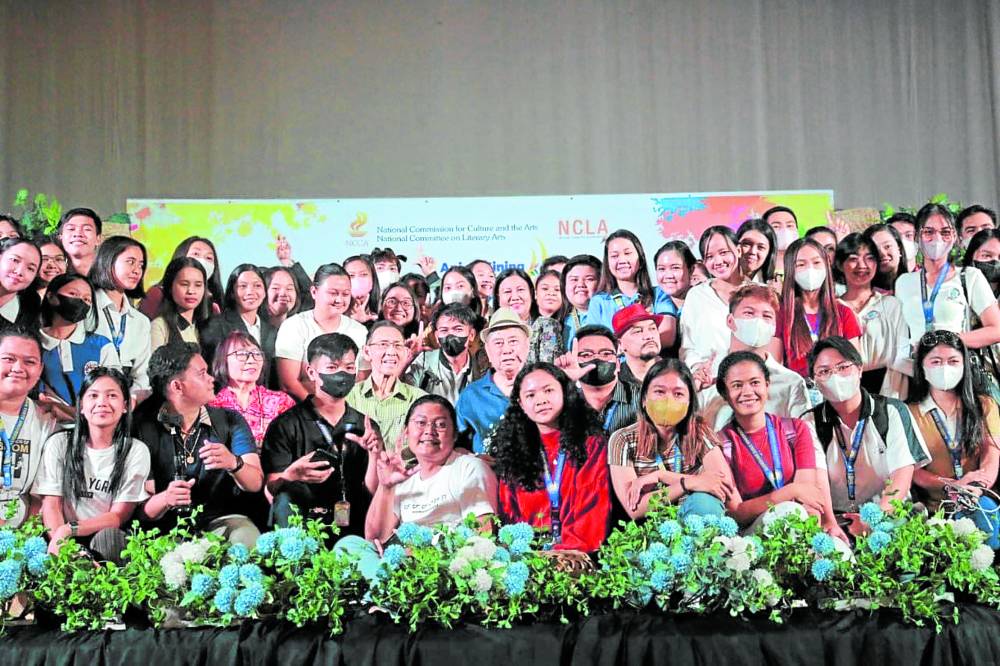
National Artist Gémino “Jimmy” Abad, poet in English, and Virgilio S. Almario (a.k.a. Rio Alma), poet in Filipino, were the main speakers in “Panitikan ng Panumduman” (Literature of Memory), a conference of the National Commission for Culture and the Arts (NCCA), held recently in Lingayen, the historic capital of Pangasinan. Their presence excited the students of Pangasinan State University.
The young attendees filled the upper levels of the conference venue, the Sison Auditorium in the Capitol Complex.
Music was provided by the young members of the Deles Alaminos Rondalla Ensemble.
Abad and Almario were not the only stars of the literary gathering, for there were leading scholars, literary critics and professors from all over the country, who discussed the works of noted Filipino writers and poets within the context of history and society.
Aaron Viernes of the Department of History, University of the Philippines (UP) Diliman, explored “memory and trauma” in two novels by Lualhati Bautista, “Dekada ’70” and “Desaparesidos.” These were set in the mid-’70s, during the time of the Marcos regime.
Viernes said, “We can see the truth behind martial law in these two works, in the family Bartolome. Anyone can be a victim of martial law, NPA (New People’s Army) or not. A few were women and children in Samar.”
‘History as burden of memory’
Junley Lazaga of UP Baguio, in a paper read by Rosalina Mendigo, wrote on the body of knowledge from the works of the turn-of-the-century revolutionary Isabelo de los Reyes, while Ian Harvey Claros of Eastern Visayas analyzed “postmemory” in the poems of Merlie Alunan on the Balangiga massacre of 1901 in Samar. Felicidad Galang-Pereña discussed “history as burden of memory” in the fiction of Eric Gamalinda, while Diane Jane Rapisora examined the quest for social justice in the short stories of (National Artist) F. Sionil José.
Honeylet Alerta and Antonino de Veyra described calamities such as supertyphoons and pollution, and the creative literature (novels, poems, etc.) that arose from these disasters, the values and inequalities dramatized in these works and how to make the “scientific stuff” accessible to the layperson. Mahar Lagmay Jr. spoke on culture in general, saying “it does not give commands, it is entertaining and it increases awareness of social conditions like climate change.”
“A country is only as good as its people’s memories,” declared Abad in his keynote address. “Without language we will have no memory, no history, no civilization. We need to imagine what the words express. The poet, writer, short story writer, playwright must imagine well, so that the work will come alive for the reader. Without imagination, there is no thinking. To think well is to imagine well, to read well is to imagine well.”
Then he added to a bemused audience, “We have evolved to what we are now and we used to be cannibals. Yes, some politicians are cannibals; they have no respect for human rights. I’ll tell you who my candidate for President was, Leni Robredo!” Wild applause.
Rock stars
On the language issue, Abad said that “all languages are sacred. Every community has its own language; we must respect each other’s consciousness, language. The national language is Tagalog-based Filipino. That’s fine but for me Filipino is not a reality.”
He advised the students. “Develop your sense of language, whether it’s Tagalog or Pangasinense.”
Almario, speaking in Filipino, asserted that “Tagalog is not [the] Filipino [language] and the national language is Filipino.” His point was that Tagalog is a regional language, while Filipino embraces the national spirit. Abad then expounded on his thoughts on language leading Almario, with tongue-in-cheek, to goodnaturedly observe: “Sasagutin ko ba ‘yon, mag-aaway lang kami. (Will I answer that, we will just argue).”
And he left it at that.
Both poets, however, stressed the importance of regional languages as embodying the soul of the native speaker. As Almario put it, “Lahat ng wika pantay-pantay (all languages are equal).”
“Our memory is not pure,” Almario declared. “What I mean is, we should study, research (‘saliksik’) our memory, and analyze (‘pagsusuri, pagsisiyasat’) the documents of history. Lapu-Lapu was old and it was not he who killed Magellan but his men.” Recent scholarship has disclosed that Lapu-Lapu was in his early ’70s and during the battle of Mactan, he was in a “safe place” (according to historian Ambeth Ocampo).
“We should not trust our memories,” the poet-critic concluded. “There is much flawed thinking in our national memories (maraming baluktot… na kaisipan sa pambasang memorya.” He traced the loss of this national consciousness to the divide-and-rule tactics of our conquerors, the Spaniards and then the Americans.
The two poets were treated like rock stars by the students who, one by one, came down to ask each national artist a face-to-face question. There were also numerous photo opportunities.
The success of NCCA’s National Committee on Literary Arts conference makes one believe that there are still young people out there who major in literature, whether in English or Filipino, who read for intelligent pleasure and not just for final exams. CONTRIBUTED